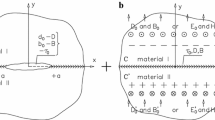By the finite-element method, we study the stress-strain state of an interface crack in a piezoelectric bimaterial polarized in the direction perpendicular to the crack faces and subjected at infinity to the action of an electric field parallel to the crack and stresses parallel to the axis of polarization. On the crack faces, we consider the main versions of electrostatic boundary conditions, namely, impermeability (insulation), electric permeability, electric conductivity, and also a version of mixed boundary conditions, i.e., electric conductivity of a middle part of the top face and insulation of the remaining part of the crack. The formation of zones of mechanical contact between the faces is possible. The problem is considered in the statement of plane deformation. The energy release rates are found with the help of the virtual crack closure integral method. It is shown that the type of boundary conditions strongly affects the parameters of fracture.
Similar content being viewed by others
References
V. Ya. Adlutskyj and V. V. Loboda, “Finite-element analysis of the elastoplastic state of a plane with elliptic inclusion in the presence of interface crack,” Mat. Met. Fiz.-Mekh. Polya, 63, No. 1, 65–74 (2020); English translation: J. Math. Sci., 270, No. 1, 76–86 (2023); https://doi.org/10.1007/s10958-023-06333-0.
N. Benkaci and G. Maugin, “J integral computation for piezo-ceramics,” Rev. Europ. Élément. Finis, 10, No. 1, 99–128 (2001); https://doi.org/10.1080/12506559.2001.11869241.
H. G. Beom and S. N. Atluri, “Conducting cracks in dissimilar piezoelectric media,” Int. J. Fract., 118, No. 4, 285–301 (2002); https://doi.org/10.1023/A:1023381215338.
C.-F. Gao, M. Zhao, P. Tong, and T.-Y. Zhang. “The energy release rate and the J-integral of an electrically insulated crack in a piezoelectric material,” Int. J. Eng. Sci., 42, Nos. 19-20, 2175–2192 (2004); https://doi.org/10.1016/j.ijengsci.2004.08.007.
D. Fang and J. Liu, Fracture Mechanics of Piezoelectric and Ferroelectric Solids, Tsinghua Univ. Press, Beijing (2013).
T. Fett, M. Kamlah, D. Munz, and G. Thun “Crack resistance and fracture toughness of PZT ceramics,” in: Proc. SPIE, 4333, Smart Structures and Materials 2001: Active Materials: Behavior and Mechanics (2001), pp. 221–230; https://doi.org/10.1117/12.432760.
O. Gruebner, M. Kamlah, and D. Munz, “Finite element analysis of cracks in piezoelectric materials taking into account the permittivity of the crack medium,” Eng. Fract. Mech., 70, No. 11, 1399–1413 (2003); https://doi.org/10.1016/S0013-7944(02)00117-0.
K. P. Herrmann, V. V. Loboda, and V. B. Govorukha, “On contact zone models for an electrically impermeable interface crack in a piezoelectric bimaterial,” Int. J. Fract., 111, No. 3, 203–227 (2001); https://doi.org/10.1023/A:1012269616735.
S. Kumar and R. N. Singh, “Crack propagation in piezoelectric materials under combined mechanical and electrical loadings,” Acta Mater., 44, No. 1, 173–200 (1996); https://doi.org/10.1016/1359-6454(95)00175-3.
S. Kumar and R. N. Singh, “Effect of the mechanical boundary condition at the crack surfaces on the stress distribution at the crack tip in piezoelectric materials,” Mater. Sci. Eng. A, 252, No. 1, 64–77 (1998); https://doi.org/10.1016/S0921-5093(98)00629-7.
S. Kumar and R. N. Singh, “Influence of applied electric field and mechanical boundary condition on the stress distribution at the crack tip in piezoelectric materials,” Mater. Sci. Eng. A, 231, Nos. 1-2, 1–9 (1997); https://doi.org/10.1016/S0921-5093(97)00038-5.
M. Kuna, “Finite element analyses of crack problems in piezoelectric structures,” Comput. Mater. Sci., 13, Nos. 1-3, 67–80 (1998); https://doi.org/10.1016/S0927-0256(98)00047-0.
M. Kuna, “Finite element analyses of cracks in piezoelectric structures,” Key Eng. Mater., 348-349, 629–632 (2007); https://doi.org/10.4028/www.scientific.net/KEM.348-349.629.
B. N. Rao and M. Kuna, “Interaction integrals for fracture analysis of functionally graded piezoelectric materials,” Int. J. Solids Struct., 45, No. 20, 5237–5257 (2008); https://doi.org/10.1016/j.ijsolstr.2008.05.020.
V. Loboda and R. Mahnken, “An investigation of an electrode at the interface of a piezoelectric bimaterial space under remote electromechanical loading,” Acta Mech., 221, Nos. 3-4, 327–339 (2011); https://doi.org/10.1007/s00707-011-0519-6.
V. Loboda, A. Sheveleva, and Y. Lapusta, “An electrically conducting interface crack with a contact zone in a piezoelectric bimaterial,” Int. J. Solids Struct., 51, No. 1, 63–73 (2014); https://doi.org/10.1016/j.ijsolstr.2013.09.012.
R. M. McMeeking, “The energy release rate for a Griffith crack in a piezoelectric material,” Eng. Fract. Mech., 71, Nos. 7-8, 1149–1163 (2004); https://doi.org/10.1016/S0013-7944(03)00135-8.
S. B. Park and C. T. Sun, “Effect of electric field on fracture of piezoelectric ceramics,” Int. J. Fract., 70, No. 3, 203–216 (1993); https://doi.org/10.1007/BF00012935.
S. B. Park and C. T. Sun, “Fracture criteria for piezoelectric ceramics,” J. Amer. Ceram. Soc., 78, No. 6, 1475–1480 (1995); https://doi.org/10.1111/j.1151-2916.1995.tb08840.x.
V. Z. Parton and B. A. Kudryavtsev, Electromagnetoelasticity, Gordon & Breach Sci. Publ., New York (1988).
E. F. Rybicki and M. F. Kanninen, “A finite element calculation of stress intensity factors by a modified crack closure integral,” Eng. Fract. Mech., 9, No. 4, 931–938 (1977); https://doi.org/10.1016/0013-7944(77)90013-3.
O. C. Zienkiewicz and R. L. Taylor, The Finite Element Method for Solid and Structural Mechanics, Vol. 2. Elsevier, Oxford (2005).
Author information
Authors and Affiliations
Corresponding author
Additional information
Translated from Matematychni Metody ta Fizyko-Mekhanichni Polya, Vol. 64, No. 4, pp. 55–67, October–December, 2021.
Rights and permissions
Springer Nature or its licensor (e.g. a society or other partner) holds exclusive rights to this article under a publishing agreement with the author(s) or other rightsholder(s); author self-archiving of the accepted manuscript version of this article is solely governed by the terms of such publishing agreement and applicable law.
About this article
Cite this article
Adlucky, V.J., Levchenko, M.S. & Loboda, V.V. Finite-Element Analysis of the Parameters of Fracture in a Piezoelectric Bimaterial with Interface Crack for Various Types of Boundary Conditions on its Faces. J Math Sci 279, 181–196 (2024). https://doi.org/10.1007/s10958-024-07004-4
Received:
Published:
Issue Date:
DOI: https://doi.org/10.1007/s10958-024-07004-4




